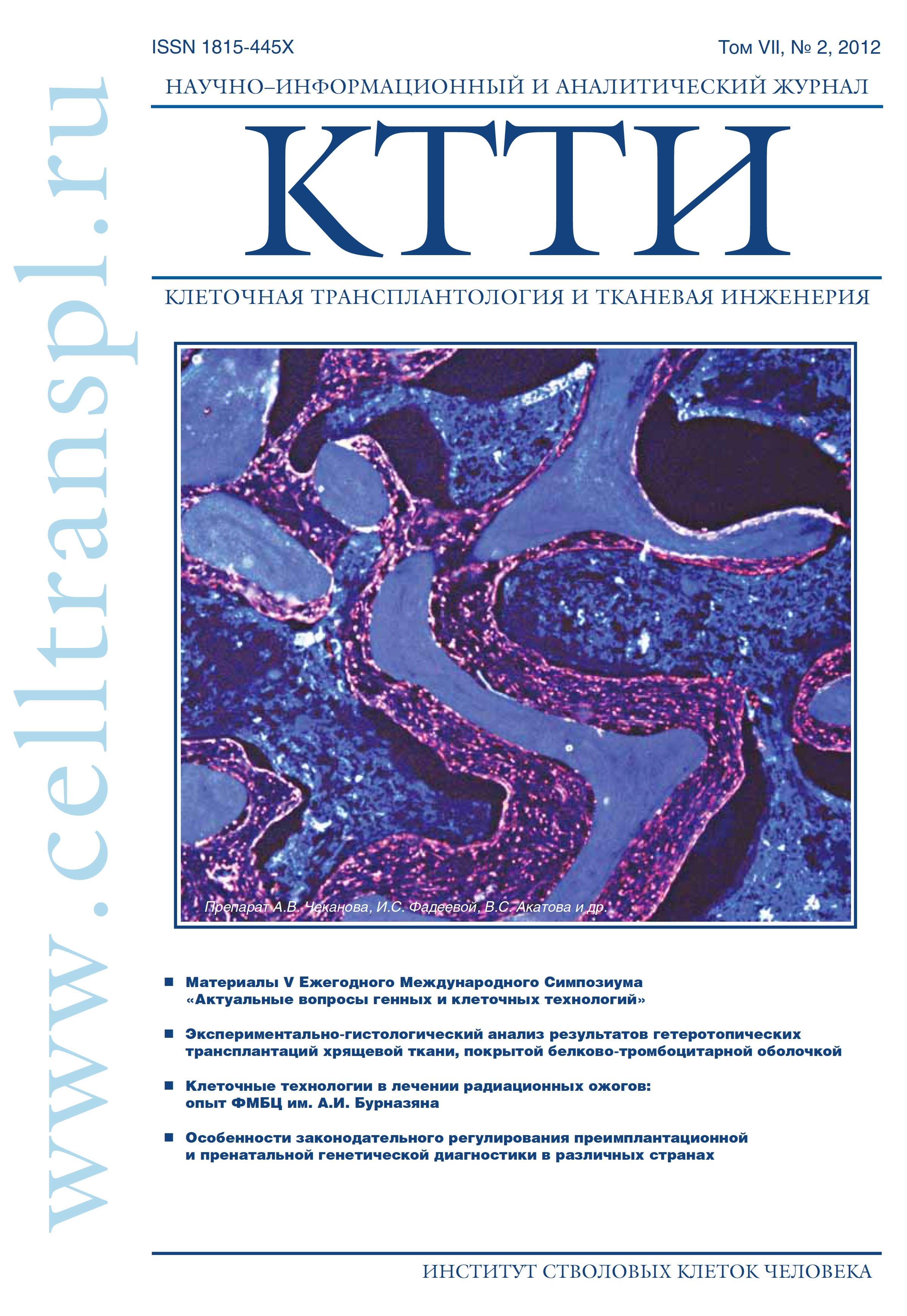Post-traumatic reactions of a rat spinal cord after transplantation of human olfactory mucosa cells
- Authors: Shajmardanova GF1, Chelyshev J.A2, Lebedev SV3, Savchenko EA3, Viktorov IV3, Karasjov AV3, Chehonin VP3
-
Affiliations:
- Kazan Institute of Biochemistry and Biophysics KSC RAS, Kazan
- Kazan State Medical University, Kazan3 Kazan (Volga region) Federal University, Kazan
- V.P. Serbsky State Scientific Center for Social and Forensic Psychiatry, Moscow
- Issue: Vol 7, No 2 (2012)
- Pages: 92-96
- Section: Articles
- Submitted: 11.01.2023
- Published: 15.06.2012
- URL: https://genescells.ru/2313-1829/article/view/121644
- DOI: https://doi.org/10.23868/gc121644
- ID: 121644
Cite item
Abstract
level effect of the immediate transplantation of the human
olfactory mucosa cell into the damaged area were studied.
No immunosuppression was used. It was shown that
transplanted cells were survived as long as 7 days after
transplantation and located in rostral and caudal directions in
white matter on the 2 mm distance from points of injections.
It was shown also that transplanted cells migrated into
peripheral zone of the damaged area. The size of damaged
area in white and especially in gray matters were decreased
after 30 and 60 days after transplantation. The same time
after 30 days after transplantation the size of pathological
cavities mostly in anterior column were obviously diminished
and that number of undamaged myelinated nerve fibers were
increased in number around the area of transplantation
About the authors
G F Shajmardanova
Kazan Institute of Biochemistry and Biophysics KSC RAS, KazanKazan Institute of Biochemistry and Biophysics KSC RAS, Kazan
Ju A Chelyshev
Kazan State Medical University, Kazan3 Kazan (Volga region) Federal University, KazanKazan State Medical University, Kazan3 Kazan (Volga region) Federal University, Kazan
S V Lebedev
V.P. Serbsky State Scientific Center for Social and Forensic Psychiatry, MoscowV.P. Serbsky State Scientific Center for Social and Forensic Psychiatry, Moscow
E A Savchenko
V.P. Serbsky State Scientific Center for Social and Forensic Psychiatry, MoscowV.P. Serbsky State Scientific Center for Social and Forensic Psychiatry, Moscow
I V Viktorov
V.P. Serbsky State Scientific Center for Social and Forensic Psychiatry, MoscowV.P. Serbsky State Scientific Center for Social and Forensic Psychiatry, Moscow
A V Karasjov
V.P. Serbsky State Scientific Center for Social and Forensic Psychiatry, MoscowV.P. Serbsky State Scientific Center for Social and Forensic Psychiatry, Moscow
V P Chehonin
V.P. Serbsky State Scientific Center for Social and Forensic Psychiatry, MoscowV.P. Serbsky State Scientific Center for Social and Forensic Psychiatry, Moscow
References
- Викторов И.В., Савченко Е.А., Чехонин В.П. Спонтанная нейральная дифференциация стволовых клеток в культуре обоня- тельного эпителия человека. Клеточные технологии в биологии и медицине 2007; 4: 183-8.
- Викторов И.В., Савченко Е.А., Чехонин В.П. Глиальные и мультипотентные стволовые клетки: перспективы их использования в нейротранспланталогии. В: Пальцев М.А., редактор. Биология стволовых клеток и клеточные технологии. Том 2. Москва: «Меди- цина», «Шико»; 2009. С.190-210.
- Лебедев С.В., Карасев А.В., Чехонин В.П. и др. Исследова- ние эффективности трансплантации нейральных стволовых клеток человека крысам с травмой спинного мозга: применение функцио- нальных нагрузочных тестов и метода ВВВ. Бюлл. эксп. биол. и мед. 2010; 149(3): 355-60.
- Лебедев С.В., Тимофеев, С.В., Жарков А.В. и др. Нагрузоч- ные тесты и метод ВВВ при оценке двигательных нарушений у крыс после контузионной травмы спинного мозга. Бюлл. эксп. биол. и мед. 2008; 145(10): 471-6.
- Масгутова Г.А., Челышев Ю.А., Жарков А.В. и др. Динамика морфологических изменений спинного мозга крысы после контузи- онной травмы различной степени тяжести. Морфологические ведо- мости 2008; 1-2: 80-3.
- Челышев Ю.А., Викторов И.В. Клеточные технологии ремие- линизации при травме спинного мозга. Неврологический вестник 2009; 1: 49-55.
- Andrews M.R., Stelzner D.J. Evaluation of olfactory ensheathing and schwann cells after implantation into a dorsal injury of adult rat spinal cord. Neurotrauma 2007; 24(11): 1773-92.
- Deng C., Gorrie C., Hayward I. et al. Survival and migration of human and rat olfactory ensheathing cells in intact and injured spinal cord. J. Neurosci. Res. 2006; 83(7): 1201-12.
- Gorrie C.A., Hayward I., Cameron N. et al. Effects of human OEC-derived cell transplants in rodent spinal cord contusion injury. Brain Res. 2010; 1337: 8-20.
- Kalincik T., Jozefcikova K., Sutharsan R. et al. Selected changes in spinal cord morphology after T4 transection and olfactory ensheathing cell transplantation. Auton. Neurosci. 2010; 158(1-2): 31-8.
- Lasiene J., Shupe L., Perlmutter S. et al. No evidence for chronic demyelination in spared axons after spinal cord injury in a mouse. J. Neurosci. 2008; 28(15): 3887-96.
- Li Y., Bao J, Khatibi N.H., Chen L. et al. Olfactory ensheathing cell transplantation into spinal cord prolongs the survival of mutant SOD1(G93A) ALS rats through neuroprotection and remyelination. Anat Rec (Hoboken). 2011; 294(5): 847-57.
- Lu P., Yang H., Culbertson M. et al. Olfactory ensheathing cells do not exhibit unique migratory or axonal growth-promoting properties after spinal cord injury. J. Neurosci. 2006; 26(43): 11120-30.
- Radtke C., Sasaki M., Lankford K.L. et al. Potential of olfactory ensheathing cells for cell-based therapy in spinal cord injury J. Rehabilitation Research & Development. 2008; 45(1): 141-52.
- Richter, M.W., Fletcher, P.A., Liu, J. et al. Lamina propria and olfactory bulb ensheathing cells exhibit differential integration and migration and promote differential axon sprouting in the lesioned spinal cord. J. Neurosci. 2005; 25: 10700-11.
- Verdú E., García-Alías G., Forés J. et al. Effects of ensheathing cells transplanted into photochemically damaged spinal cord. Neuroreport 2001; 12(11): 2303-09.
Supplementary files










